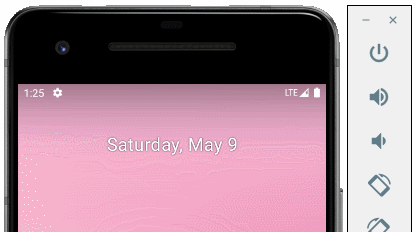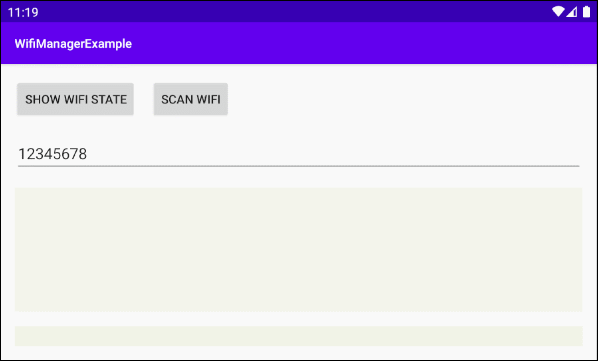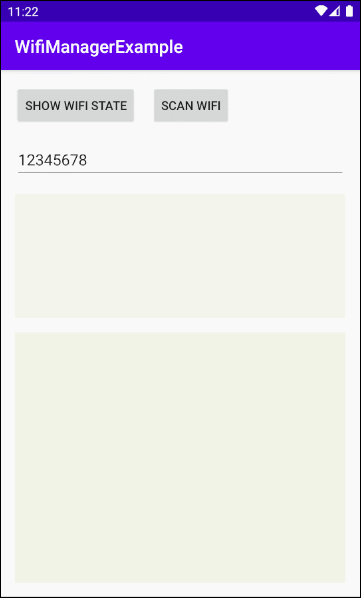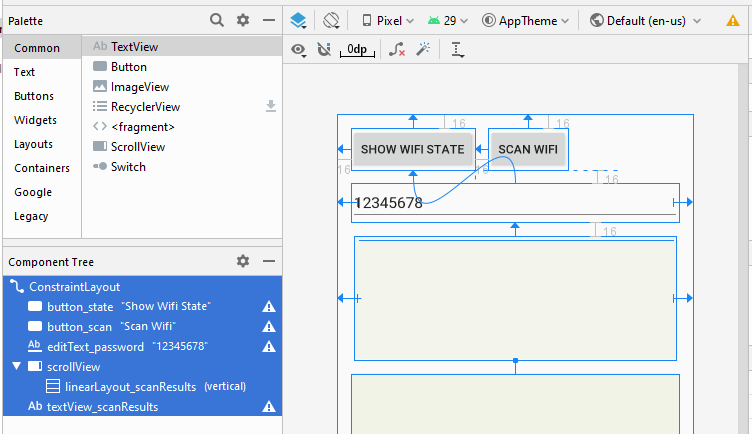Android Wifi Scanning Tutorial with Examples
1. Android Wi-Fi
In Android, Wi-Fi is known as a Wireless Network Protocol. It permits devices to get connected to the Internet or devices connected to each other for data exchange.
Specifically, Android provides the Wi-Fi API that applications can use the API to manage all aspects related to Wifi connectivity, such as searching for current Wifi networks, adding, saving, deleting Wifi connections, as well as managing data exchanged among devices.

In case you use the Wi-Fi API in your application, you can perform the following functions:
- Scan to search for available Wifi networks in a range.
- Allow devices to get connected to the Internet.
- Connect to other devices via Service Discovery.
- Manage a list of the configured networks.
- Manage multiple connections.
Since Android 10.0 (API Level 29), you cannot use the Wi-Fi API in order to enable/disable the WiFi of thesystem,. It means that if you want to enable/disable Wifi, you have to use the available function of the operating system.

The privacy policy for using the Wi-Fi API to enable/disable Wifi has changed a few times over different versions of Android. More spercifically:
Android Level | Privacy policy |
Level 1 ==> Level 22
(Android < 6.0) | Android.permission.CHANGE_WIFI_STATE needs to be added to AndroidManifest.xml. |
Level 23 ==> Level 28
(Android 6.0 - 9.x) | Android.permission.CHANGE_WIFI_STATE needs to be added to AndroidManifest.xml. Simultaneously, the application must ask the user to allow it to enable/ disable the Wifi of the system. |
Level 29+
(Android 10.0+) | Wi-Fi API is not permitted to enable/ disable the Wifi of the system. |
* AndroidManifest.xml *
<uses-permission android:name="android.permission.CHANGE_WIFI_STATE" />WifiManager wifiManager = (WifiManager)getApplicationContext().getSystemService(Context.WIFI_SERVICE);
wifiManager.setWifiEnabled(true); // Enable Wifi
wifiManager.setWifiEnabled(false); // Disable WifiIn Android 10+ (API Level 29+), setWifiEnabled(boolean) is not in use anymore.
To get the Wifi status, you need to add android.permission.ACCESS_WIFI_STATE to AndroidManifest.xml:
* AndroidManifest.xml *
<uses-permission android:name="android.permission.ACCESS_WIFI_STATE" />WifiManager wifiManager = (WifiManager)getApplicationContext().getSystemService(Context.WIFI_SERVICE);
int state = wifiManager.getWifiState();
String statusInfo = "Unknown";
switch (state) {
case WifiManager.WIFI_STATE_DISABLING:
statusInfo = "Disabling";
break;
case WifiManager.WIFI_STATE_DISABLED:
statusInfo = "Disabled";
break;
case WifiManager.WIFI_STATE_ENABLING:
statusInfo = "Enabling";
break;
case WifiManager.WIFI_STATE_ENABLED:
statusInfo = "Enabled";
break;
case WifiManager.WIFI_STATE_UNKNOWN:
statusInfo = "Unknown";
break;
default:
statusInfo = "Unknown";
break;
}Scan to search for the current networks:
WifiManager wifiManager = (WifiManager)getApplicationContext().getSystemService(Context.WIFI_SERVICE);
// Get List of Available Wifi Networks
List<ScanResult> availNetworks = wifiManager.getScanResults();
if (availNetworks.size() > 0) {
// Get Each network detail
for (int i=0; i< availNetworks.size();i++) {
// ...
}
}The privacy policy for scanning current networks has changed a few times to different Android versions:
Android API Level | Privacy policy |
Level 1 ==> Level 2 | Android.permission.ACCESS_COARSE_LOCATION needs to be added to AndroidManifest.xml. |
Level 23+
(Android 6.0+) | Android.permission.ACCESS_COARSE_LOCATION needs to be added to AndroidManifest.xml. And your application must ask the user for permission to scan (current) networks. |
* AndroidManifest.xml *
<uses-permission android:name="android.permission.ACCESS_COARSE_LOCATION" />
- Android Wifi Direct P2P
2. Example of WifiManager
In this example, I'm going to show you how to use WifiManager to retrieve the status of the Wifi, scan the current networks, write down the details of each found network, and finally, connect to a certain network in the list.
Example preview:


First, on Android Studio, create a new project:
- File > New > New Project > Empty Activity
- Name: WifiManagerExample
- Package name: org.o7planning.wifimanagerexample
- Language: Java
Then add the permissions to the application:
<uses-permission android:name="android.permission.ACCESS_WIFI_STATE" />
<uses-permission android:name="android.permission.CHANGE_WIFI_STATE" />
<uses-permission android:name="android.permission.ACCESS_NETWORK_STATE" />
<uses-permission android:name="android.permission.ACCESS_COARSE_LOCATION" />
<uses-permission android:name="android.permission.ACCESS_FINE_LOCATION" />AndroidManifest.xml
<?xml version="1.0" encoding="utf-8"?>
<manifest xmlns:android="http://schemas.android.com/apk/res/android"
package="org.o7planning.wifimanagerexample">
<uses-permission android:name="android.permission.ACCESS_WIFI_STATE" />
<uses-permission android:name="android.permission.CHANGE_WIFI_STATE" />
<uses-permission android:name="android.permission.ACCESS_NETWORK_STATE" />
<uses-permission android:name="android.permission.ACCESS_COARSE_LOCATION" />
<uses-permission android:name="android.permission.ACCESS_FINE_LOCATION" />
<application
android:allowBackup="true"
android:icon="@mipmap/ic_launcher"
android:label="@string/app_name"
android:roundIcon="@mipmap/ic_launcher_round"
android:supportsRtl="true"
android:theme="@style/AppTheme">
<activity android:name=".MainActivity">
<intent-filter>
<action android:name="android.intent.action.MAIN" />
<category android:name="android.intent.category.LAUNCHER" />
</intent-filter>
</activity>
</application>
</manifest>And here is the example interface of the application:

activity_main.xml
<?xml version="1.0" encoding="utf-8"?>
<androidx.constraintlayout.widget.ConstraintLayout
xmlns:android="http://schemas.android.com/apk/res/android"
xmlns:app="http://schemas.android.com/apk/res-auto"
xmlns:tools="http://schemas.android.com/tools"
android:layout_width="match_parent"
android:layout_height="match_parent"
tools:context=".MainActivity">
<Button
android:id="@+id/button_state"
android:layout_width="wrap_content"
android:layout_height="wrap_content"
android:layout_marginStart="16dp"
android:layout_marginLeft="16dp"
android:layout_marginTop="16dp"
android:text="Show Wifi State"
app:layout_constraintStart_toStartOf="parent"
app:layout_constraintTop_toTopOf="parent" />
<Button
android:id="@+id/button_scan"
android:layout_width="wrap_content"
android:layout_height="wrap_content"
android:layout_marginStart="16dp"
android:layout_marginLeft="16dp"
android:layout_marginTop="16dp"
android:text="Scan Wifi"
app:layout_constraintStart_toEndOf="@+id/button_state"
app:layout_constraintTop_toTopOf="parent" />
<EditText
android:id="@+id/editText_password"
android:layout_width="0dp"
android:layout_height="wrap_content"
android:layout_marginStart="16dp"
android:layout_marginLeft="16dp"
android:layout_marginTop="16dp"
android:layout_marginEnd="16dp"
android:layout_marginRight="16dp"
android:ems="10"
android:inputType="textPersonName"
android:text="12345678"
app:layout_constraintEnd_toEndOf="parent"
app:layout_constraintStart_toStartOf="parent"
app:layout_constraintTop_toBottomOf="@+id/button_state" />
<ScrollView
android:id="@+id/scrollView"
android:layout_width="0dp"
android:layout_height="143dp"
android:layout_marginStart="16dp"
android:layout_marginLeft="16dp"
android:layout_marginTop="16dp"
android:layout_marginEnd="16dp"
android:layout_marginRight="16dp"
android:background="#F3F4EB"
app:layout_constraintEnd_toEndOf="parent"
app:layout_constraintStart_toStartOf="parent"
app:layout_constraintTop_toBottomOf="@+id/editText_password">
<LinearLayout
android:id="@+id/linearLayout_scanResults"
android:layout_width="match_parent"
android:layout_height="wrap_content"
android:layout_marginLeft="5sp"
android:layout_marginTop="5sp"
android:layout_marginRight="5sp"
android:layout_marginBottom="5sp"
android:orientation="vertical" />
</ScrollView>
<TextView
android:id="@+id/textView_scanResults"
android:layout_width="0dp"
android:layout_height="0dp"
android:layout_marginStart="16dp"
android:layout_marginLeft="16dp"
android:layout_marginTop="16dp"
android:layout_marginEnd="16dp"
android:layout_marginRight="16dp"
android:layout_marginBottom="16dp"
android:background="#F1F3E7"
android:inputType="textMultiLine"
app:layout_constraintBottom_toBottomOf="parent"
app:layout_constraintEnd_toEndOf="parent"
app:layout_constraintStart_toStartOf="parent"
app:layout_constraintTop_toBottomOf="@+id/scrollView" />
</androidx.constraintlayout.widget.ConstraintLayout>MainActivity.java
package org.o7planning.wifimanagerexample;
import androidx.appcompat.app.AppCompatActivity;
import androidx.core.app.ActivityCompat;
import androidx.core.content.ContextCompat;
import android.Manifest;
import android.content.BroadcastReceiver;
import android.content.Context;
import android.content.Intent;
import android.content.IntentFilter;
import android.content.pm.PackageManager;
import android.net.wifi.ScanResult;
import android.net.wifi.WifiConfiguration;
import android.net.wifi.WifiManager;
import android.os.Build;
import android.os.Bundle;
import android.util.Log;
import android.view.View;
import android.widget.Button;
import android.widget.EditText;
import android.widget.LinearLayout;
import android.widget.TextView;
import android.widget.Toast;
import java.util.List;
public class MainActivity extends AppCompatActivity {
private static final String LOG_TAG = "AndroidExample";
private static final int MY_REQUEST_CODE = 123;
private WifiManager wifiManager;
private Button buttonState;
private Button buttonScan;
private EditText editTextPassword;
private LinearLayout linearLayoutScanResults;
private TextView textViewScanResults;
private WifiBroadcastReceiver wifiReceiver;
@Override
protected void onCreate(Bundle savedInstanceState) {
super.onCreate(savedInstanceState);
setContentView(R.layout.activity_main);
this.wifiManager = (WifiManager) this.getApplicationContext().getSystemService(Context.WIFI_SERVICE);
// Instantiate broadcast receiver
this.wifiReceiver = new WifiBroadcastReceiver();
// Register the receiver
registerReceiver(wifiReceiver, new IntentFilter(WifiManager.SCAN_RESULTS_AVAILABLE_ACTION));
//
this.buttonState = (Button) this.findViewById(R.id.button_state);
this.buttonScan = (Button) this.findViewById(R.id.button_scan);
this.editTextPassword = (EditText) this.findViewById(R.id.editText_password);
this.textViewScanResults = (TextView) this.findViewById(R.id.textView_scanResults);
this.linearLayoutScanResults = (LinearLayout) this.findViewById(R.id.linearLayout_scanResults);
this.buttonState.setOnClickListener(new View.OnClickListener(){
@Override
public void onClick(View v) {
showWifiState();
}
});
this.buttonScan.setOnClickListener(new View.OnClickListener() {
@Override
public void onClick(View v) {
askAndStartScanWifi();
}
});
}
private void askAndStartScanWifi() {
// With Android Level >= 23, you have to ask the user
// for permission to Call.
if (android.os.Build.VERSION.SDK_INT >= android.os.Build.VERSION_CODES.M) { // 23
int permission1 = ContextCompat.checkSelfPermission(this, Manifest.permission.ACCESS_COARSE_LOCATION);
// Check for permissions
if (permission1 != PackageManager.PERMISSION_GRANTED) {
Log.d(LOG_TAG, "Requesting Permissions");
// Request permissions
ActivityCompat.requestPermissions(this,
new String[] {
Manifest.permission.ACCESS_COARSE_LOCATION,
Manifest.permission.ACCESS_FINE_LOCATION,
Manifest.permission.ACCESS_WIFI_STATE,
Manifest.permission.ACCESS_NETWORK_STATE
}, MY_REQUEST_CODE);
return;
}
Log.d(LOG_TAG, "Permissions Already Granted");
}
this.doStartScanWifi();
}
private void doStartScanWifi() {
this.wifiManager.startScan();
}
@Override
public void onRequestPermissionsResult(int requestCode, String permissions[], int[] grantResults) {
Log.d(LOG_TAG, "onRequestPermissionsResult");
switch (requestCode) {
case MY_REQUEST_CODE: {
// If request is cancelled, the result arrays are empty.
if (grantResults.length > 0 && grantResults[0] == PackageManager.PERMISSION_GRANTED) {
// permission was granted
Log.d(LOG_TAG, "Permission Granted: " + permissions[0]);
// Start Scan Wifi.
this.doStartScanWifi();
} else {
// Permission denied, boo! Disable the
// functionality that depends on this permission.
Log.d(LOG_TAG, "Permission Denied: " + permissions[0]);
}
break;
}
// Other 'case' lines to check for other
// permissions this app might request.
}
}
private void showWifiState() {
int state = this.wifiManager.getWifiState();
String statusInfo = "Unknown";
switch (state) {
case WifiManager.WIFI_STATE_DISABLING:
statusInfo = "Disabling";
break;
case WifiManager.WIFI_STATE_DISABLED:
statusInfo = "Disabled";
break;
case WifiManager.WIFI_STATE_ENABLING:
statusInfo = "Enabling";
break;
case WifiManager.WIFI_STATE_ENABLED:
statusInfo = "Enabled";
break;
case WifiManager.WIFI_STATE_UNKNOWN:
statusInfo = "Unknown";
break;
default:
statusInfo = "Unknown";
break;
}
Toast.makeText(this, "Wifi Status: " + statusInfo, Toast.LENGTH_LONG).show();
}
@Override
protected void onStop() {
this.unregisterReceiver(this.wifiReceiver);
super.onStop();
}
// Define class to listen to broadcasts
class WifiBroadcastReceiver extends BroadcastReceiver {
@Override
public void onReceive(Context context, Intent intent) {
Log.d(LOG_TAG, "onReceive()");
Toast.makeText(MainActivity.this, "Scan Complete!", Toast.LENGTH_SHORT).show();
boolean ok = intent.getBooleanExtra(WifiManager.EXTRA_RESULTS_UPDATED, false);
if (ok) {
Log.d(LOG_TAG, "Scan OK");
List<ScanResult> list = wifiManager.getScanResults();
MainActivity.this.showNetworks(list);
MainActivity.this.showNetworksDetails(list);
} else {
Log.d(LOG_TAG, "Scan not OK");
}
}
}
private void showNetworks(List<ScanResult> results) {
this.linearLayoutScanResults.removeAllViews();
for( final ScanResult result: results) {
final String networkCapabilities = result.capabilities;
final String networkSSID = result.SSID; // Network Name.
//
Button button = new Button(this );
button.setText(networkSSID + " ("+networkCapabilities+")");
this.linearLayoutScanResults.addView(button);
button.setOnClickListener(new View.OnClickListener() {
@Override
public void onClick(View v) {
String networkCapabilities = result.capabilities;
connectToNetwork(networkCapabilities, networkSSID);
}
});
}
}
private void showNetworksDetails(List<ScanResult> results) {
this.textViewScanResults.setText("");
StringBuilder sb = new StringBuilder();
sb.append("Result Count: " + results.size());
for(int i = 0; i < results.size(); i++ ) {
ScanResult result = results.get(i);
sb.append("\n\n --------- Network " + i + "/" + results.size() + " ---------");
sb.append("\n result.capabilities: " + result.capabilities);
sb.append("\n result.SSID: " + result.SSID); // Network Name.
sb.append("\n result.BSSID: " + result.BSSID);
sb.append("\n result.frequency: " + result.frequency);
sb.append("\n result.level: " + result.level);
sb.append("\n result.describeContents(): " + result.describeContents());
if (Build.VERSION.SDK_INT >= Build.VERSION_CODES.JELLY_BEAN_MR1) { // Level 17, Android 4.2
sb.append("\n result.timestamp: " + result.timestamp);
}
if (Build.VERSION.SDK_INT >= Build.VERSION_CODES.M) { // Level 23, Android 6.0
sb.append("\n result.centerFreq0: " + result.centerFreq0);
sb.append("\n result.centerFreq1: " + result.centerFreq1);
sb.append("\n result.venueName: " + result.venueName);
sb.append("\n result.operatorFriendlyName: " + result.operatorFriendlyName);
sb.append("\n result.channelWidth: " + result.channelWidth);
sb.append("\n result.is80211mcResponder(): " + result.is80211mcResponder());
sb.append("\n result.isPasspointNetwork(): " + result.isPasspointNetwork() );
}
}
this.textViewScanResults.setText(sb.toString());
}
private void connectToNetwork(String networkCapabilities, String networkSSID) {
Toast.makeText(this, "Connecting to network: "+ networkSSID, Toast.LENGTH_SHORT).show();
String networkPass = this.editTextPassword.getText().toString();
//
WifiConfiguration wifiConfig = new WifiConfiguration();
wifiConfig.SSID = "\"" + networkSSID + "\"";
if(networkCapabilities.toUpperCase().contains("WEP")) { // WEP Network.
Toast.makeText(this, "WEP Network", Toast.LENGTH_SHORT).show();
wifiConfig.wepKeys[0] = "\"" + networkPass + "\"";
wifiConfig.wepTxKeyIndex = 0;
wifiConfig.allowedKeyManagement.set(WifiConfiguration.KeyMgmt.NONE);
wifiConfig.allowedGroupCiphers.set(WifiConfiguration.GroupCipher.WEP40);
} else if(networkCapabilities.toUpperCase().contains("WPA")) { // WPA Network
Toast.makeText(this, "WPA Network", Toast.LENGTH_SHORT).show();
wifiConfig.preSharedKey = "\""+ networkPass +"\"";
} else { // OPEN Network.
Toast.makeText(this, "OPEN Network", Toast.LENGTH_SHORT).show();
wifiConfig.allowedKeyManagement.set(WifiConfiguration.KeyMgmt.NONE);
}
this.wifiManager.addNetwork(wifiConfig);
List<WifiConfiguration> list = this.wifiManager.getConfiguredNetworks();
for( WifiConfiguration config : list ) {
if(config.SSID != null && config.SSID.equals("\"" + networkSSID + "\"")) {
this.wifiManager.disconnect();
this. wifiManager.enableNetwork(config.networkId, true);
this.wifiManager.reconnect();
break;
}
}
}
}Android Programming Tutorials
- Configure Android Emulator in Android Studio
- Android ToggleButton Tutorial with Examples
- Create a simple File Finder Dialog in Android
- Android TimePickerDialog Tutorial with Examples
- Android DatePickerDialog Tutorial with Examples
- What is needed to get started with Android?
- Install Android Studio on Windows
- Install Intel® HAXM for Android Studio
- Android AsyncTask Tutorial with Examples
- Android AsyncTaskLoader Tutorial with Examples
- Android Tutorial for Beginners - Basic examples
- How to know the phone number of Android Emulator and change it
- Android TextInputLayout Tutorial with Examples
- Android CardView Tutorial with Examples
- Android ViewPager2 Tutorial with Examples
- Get Phone Number in Android using TelephonyManager
- Android Phone Call Tutorial with Examples
- Android Wifi Scanning Tutorial with Examples
- Android 2D Game Tutorial for Beginners
- Android DialogFragment Tutorial with Examples
- Android CharacterPickerDialog Tutorial with Examples
- Android Tutorial for Beginners - Hello Android
- Using Android Device File Explorer
- Enable USB Debugging on Android Device
- Android UI Layouts Tutorial with Examples
- Android SMS Tutorial with Examples
- Android SQLite Database Tutorial with Examples
- Google Maps Android API Tutorial with Examples
- Android Text to Speech Tutorial with Examples
- Android Space Tutorial with Examples
- Android Toast Tutorial with Examples
- Create a custom Android Toast
- Android SnackBar Tutorial with Examples
- Android TextView Tutorial with Examples
- Android TextClock Tutorial with Examples
- Android EditText Tutorial with Examples
- Android TextWatcher Tutorial with Examples
- Format Credit Card Number with Android TextWatcher
- Android Clipboard Tutorial with Examples
- Create a simple File Chooser in Android
- Android AutoCompleteTextView and MultiAutoCompleteTextView Tutorial with Examples
- Android ImageView Tutorial with Examples
- Android ImageSwitcher Tutorial with Examples
- Android ScrollView and HorizontalScrollView Tutorial with Examples
- Android WebView Tutorial with Examples
- Android SeekBar Tutorial with Examples
- Android Dialog Tutorial with Examples
- Android AlertDialog Tutorial with Examples
- Android RatingBar Tutorial with Examples
- Android ProgressBar Tutorial with Examples
- Android Spinner Tutorial with Examples
- Android Button Tutorial with Examples
- Android Switch Tutorial with Examples
- Android ImageButton Tutorial with Examples
- Android FloatingActionButton Tutorial with Examples
- Android CheckBox Tutorial with Examples
- Android RadioGroup and RadioButton Tutorial with Examples
- Android Chip and ChipGroup Tutorial with Examples
- Using image assets and icon assets of Android Studio
- Setting SD Card for Android Emulator
- ChipGroup and Chip Entry Example
- How to add external libraries to Android Project in Android Studio?
- How to disable the permissions already granted to the Android application?
- How to remove applications from Android Emulator?
- Android LinearLayout Tutorial with Examples
- Android TableLayout Tutorial with Examples
- Android FrameLayout Tutorial with Examples
- Android QuickContactBadge Tutorial with Examples
- Android StackView Tutorial with Examples
- Android Camera Tutorial with Examples
- Android MediaPlayer Tutorial with Examples
- Android VideoView Tutorial with Examples
- Playing Sound effects in Android with SoundPool
- Android Networking Tutorial with Examples
- Android JSON Parser Tutorial with Examples
- Android SharedPreferences Tutorial with Examples
- Android Internal Storage Tutorial with Examples
- Android External Storage Tutorial with Examples
- Android Intents Tutorial with Examples
- Example of an explicit Android Intent, calling another Intent
- Example of implicit Android Intent, open a URL, send an email
- Android Services Tutorial with Examples
- Android Notifications Tutorial with Examples
- Android DatePicker Tutorial with Examples
- Android TimePicker Tutorial with Examples
- Android Chronometer Tutorial with Examples
- Android OptionMenu Tutorial with Examples
- Android ContextMenu Tutorial with Examples
- Android PopupMenu Tutorial with Examples
- Android Fragments Tutorial with Examples
- Android ListView Tutorial with Examples
- Android ListView with Checkbox using ArrayAdapter
- Android GridView Tutorial with Examples
Show More